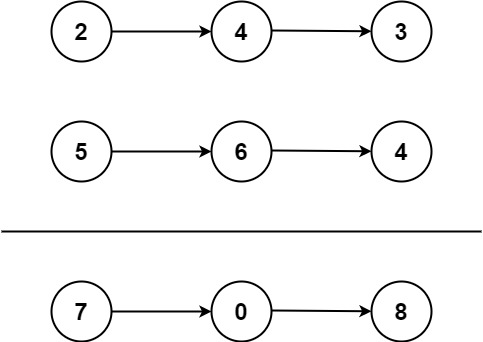本文最后更新于 2022年5月27日 下午
Linked List in Python 原题 5月16日 这两天写了两道 LeetCode 题目,都是关于单向链表(Singly linked list)的,分别是 2. Add Two Numbers (Medium) 以及 21. Merge Two Sorted Lists (Easy) 。由简到难,先做了后者再去尝试了前者。
非常巧的是,在做第21题前,刚好了解到了归并排序(Merge sort),并且试着用python写了一个归并脚本,只不过当时只用了 python 内置的数组。
5月27日更新 刚刚完成了 148. Sort List (Medium) ,用单向链表实现排序。
单向链表与节点 单向链表,顾名思义只有从前往后的单向连接,反之则不行。使用单向列表的好处在于,当需要在链表中插入数据时,只需要遍历链表找到需要插入数据的位置,将前一个节点改为指向新节点,并且让新节点指向后继节点即可,省去了数组中元素后移的麻烦。删除同理。
在实际代码中往往用第一个节点来指代整个链表。
在 LeetCode 题目中,单个节点的定义如下:
1 2 3 4 class ListNode :def __init__ (self, val=0 , next =None ):next = next
也就是说,一个节点只有它本身的值(val)以及next两个属性,其中 next 用来指向下一个节点。通过 list1 = list.next 来移动到下一个节点,当 list1 == None 时(或 list1.next == None,即没有后继节点),链表结束。
一般情况下还会定义一个 LinkedList 类,把查找、插入、删除等函数都打包进类里。LeetCode这里属于是极简配置了,但不影响数据结构的讨论。
解题 先看简单的第21题。
第21题 合并有序链表 21. Merge Two Sorted Lists
题目要求将两个由小到大排序的单向链表合并成一个,输入和输出都是 ListNode 实例。
先上代码:
1 2 3 4 5 6 7 8 9 10 11 12 13 14 15 16 17 18 19 20 21 22 23 24 25 26 27 28 29 30 31 32 33 34 35 36 37 38 39 40 41 42 43 class Solution :def mergeTwoLists (self, list1: Optional [ListNode], list2: Optional [ListNode] ) -> Optional [ListNode]: if not list1:return list2 elif not list2:return list1if list1.val <= list2.val:next else :next while list1 != None and list2 != None :if list1.val <= list2.val:next else :next next = currentnext if list1 != None :while list1 != None :next = list1next next elif list2 != None :while list2 != None :next = list2next next return head
这里值得注意的是和python内置的数组一样,while list1 != None: 和 while list1: 意义相同,都表示‘不为空时’。当节点为 None 时,逻辑值相当于 False。
这个解法看起来略显繁琐,但是运行时间和占用内存都并不大,也很容易理解。
第2题 反向求和 2. Add Two Numbers (Medium)
这道题目本身还挺搞的,把两个需要相加的数倒了过来,每个数位都放在链表的节点中,如下所示:
这里注意到的是数字高位和低位颠倒了过来,因此相加时新的数位产生在最右侧。
代码如下:
1 2 3 4 5 6 7 8 9 10 11 12 13 14 15 16 17 18 19 20 21 22 23 24 25 26 27 28 29 30 31 32 33 34 35 36 37 38 39 40 41 42 43 44 45 46 47 48 class Solution :def addTwoNumbers (self, l1: Optional [ListNode], l2: Optional [ListNode] ) -> Optional [ListNode]:0 while l1 != None :if l2 != None :0 if ans > 9 :10 1 else :next else :0 if ans > 9 :10 1 else :if l1.next != None or upper == 1 or l2 != None :next = ListNode()next next while l2 != None :0 if ans > 9 :10 1 else : if l2.next != None or upper == 1 :next = ListNode()next next if upper == 1 :1 return header
思路和上一题一样,取出一个数后移动节点,需要注意的是逢十进一。此处还有优化空间。
但是这次不同的是我选择新创建了一个节点实例来表示输出链表(output = ListNode()),实际上和使用已有链表来初始化作用相同。
第148题 链表排序 148. Sort List (Medium)
题目要求很简单,将输入链表排序后输出。
冒泡 很显然,最容易想到和代码实现的排序方法就是冒泡排序。以下是我第一次尝试时写的代码。
1 2 3 4 5 6 7 8 9 10 11 12 13 14 15 16 class Solution :def sortList (self, head: Optional [ListNode] ) -> Optional [ListNode]:True while exchange:False while current and current.next :if current.val > current.next .val:next .valnext .val = midTrue next return head
但非常可惜的是,当测试用例极大时,使用冒泡排序会超时。
Time Limit Exceeded
归并 意外发现用单向链表实现归并排序会比用 list 方便很多,尤其是归并这一步,但是不太容易想到。
1 2 3 4 5 6 7 8 9 10 11 12 13 14 15 16 17 18 19 20 21 22 23 24 25 26 27 28 29 30 31 32 33 34 35 36 37 38 39 40 41 class Solution :def sortList (self, head: Optional [ListNode] ) -> Optional [ListNode]:if head is None or head.next is None :return headnext next = None return mergedef merge (self, LN1, LN2 ):while LN1 and LN2:if LN1.val < LN2.val:next = LN1next else :next = LN2next next if LN1:next = LN1elif LN2:next = LN2next return outdef get_mid (self, head ):next while True :if b and b.next :next next .next else :return a
笔记 在整个编程过程中,最需要注意的还是链表的末尾。一不小心经常容易出现赋值给 None 或者取值 None.next 的报错。
